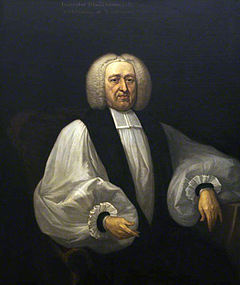Lancelot Blackburne
|
The Most Reverend and Right Honourable Lancelot Blackburne |
|
|---|---|
| Archbishop of York | |

Archbishop Blackburne (attr. Joseph Highmore)
|
|
| Province | Province of York |
| Diocese | Diocese of York |
| In office | 1724–1743 (death) |
| Predecessor | William Dawes |
| Successor | Thomas Herring |
| Other posts |
Dean of Exeter (1705–1717) Archdeacon of Cornwall (1715–1717) Personal chaplain to George I (1716) Bishop of Exeter (1717–1724) Lord High Almoner (1723–1743) |
| Orders | |
| Ordination | 1681 (deacon) |
| Consecration | 1717 |
| Personal details | |
| Born |
10 December 1658 London, [Great Britain |
| Died | 23 March 1743 (aged 84) |
| Buried | St Margaret's, Westminster |
| Nationality | British |
| Denomination | Anglicanism |
| Spouse | Catherine (m. 1684–1726) |
| Education | Westminster School |
| Alma mater | Christ Church, Oxford |
Lancelot Blackburne PC (sometimes Blackburn, Blackborne or Blackbourn[e]; 10 December 1658 – 23 March 1743) was an English clergyman, who became Archbishop of York, and – in popular belief – a pirate.
He was described by Horace Walpole, in his Memories, as "…Blackbourn, the jolly old Archbishop of York, who had all the manners of a man of quality, though he had been a buccaneer, and was a clergyman; but he retained nothing of his first profession, except his seraglio."
He was born in London, a younger brother of Richard Blackburne. He attended Westminster School, and in 1676 entered Christ Church, Oxford. He graduated in 1680, was ordained a deacon on 25 September 1681 at Christ Church by John Fell, Bishop of Oxford, and travelled to the West Indies. In January 1684 he was granted an MA by the university; at this time, he is known to have been in Nevis. A popular story recounts that he spent these years sailing with buccaneers, either as their chaplain or as a pirate himself; there is little evidence either way, although a record of 1681 notes that he was paid £20 (equivalent to £2,827 in 2015) by Charles II for "secret services".
He returned to England during 1684, marrying Catherine Talbot (the elder sister of William Talbot) on 2 September at the Savoy Chapel, and shortly thereafter took up the first of a set of church posts.
In 1691 he became a Canon of Exeter, and in 1705 Dean of Exeter, succeeding William Wake whose patronage would later stand him in good stead, and in 1715 Archdeacon of Cornwall. In 1716 he travelled to Hanover as the personal chaplain to George I and the next year became Bishop of Exeter. As Bishop, he was active in the House of Lords where he supported the repeal of the Occasional Conformity Act.
...
Wikipedia
